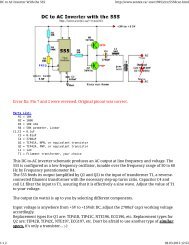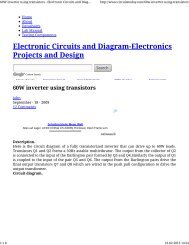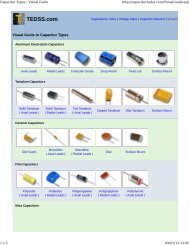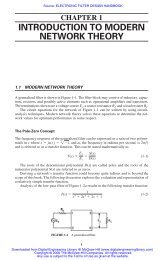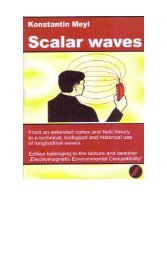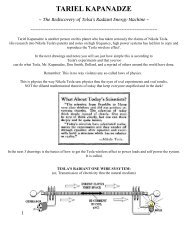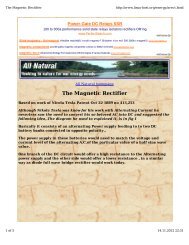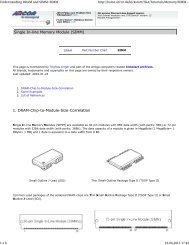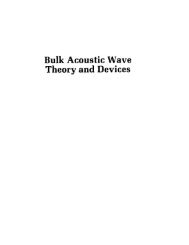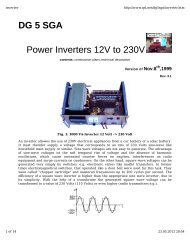New Energy Technologies Magazine nr 3 2005.pdf - Index of
New Energy Technologies Magazine nr 3 2005.pdf - Index of
New Energy Technologies Magazine nr 3 2005.pdf - Index of
You also want an ePaper? Increase the reach of your titles
YUMPU automatically turns print PDFs into web optimized ePapers that Google loves.
This possibility was controlled by using a<br />
swirler as a passive mechanoactivator and<br />
forwarding a cold water under strong pressure<br />
at its inlet [58].<br />
Due to the mechanoactivation, a water stream in<br />
the swirler was characterized by a strong<br />
maldistribution <strong>of</strong> local speeds and, accordingly,<br />
by high gradients <strong>of</strong> mechanical tensions in the<br />
liquid. Regions with negative pressures appeared<br />
in the stream and conditions were formed for<br />
tearing <strong>of</strong> the liquid's continuity and<br />
development <strong>of</strong> cavitation processes. These<br />
processes were accompanied by a clear sign <strong>of</strong><br />
cavitation – a sonoluminescent glow <strong>of</strong> the liquid<br />
[59, 60] while a cavitating hot water, which was<br />
in a condition close to a dispersion one, was<br />
coming to the exit <strong>of</strong> the swirler.<br />
While an initial water temperature had been T 1<br />
= 20C at the swirler’s inlet, a water temperature<br />
after a mechanical treatment increased up to T 2<br />
= 55C. While the initial water temperature had<br />
been T 1<br />
= 40C, the water temperature after the<br />
mechanical treatment increased up to T 2<br />
= 85C.<br />
While the initial water temperature had been T 1<br />
= 66.5C, a boiling water came to the outlet <strong>of</strong> the<br />
swirler.<br />
A comparative appraisal <strong>of</strong> a quantity <strong>of</strong><br />
heat, which is equivalent to a<br />
mechanoactivation work, and a quantity <strong>of</strong><br />
heat, which is necessary for water heating in<br />
the given temperature intervals, allows<br />
making a conclusion that an additional heat<br />
generation happens during the<br />
mechanoactivation process.<br />
During the mechanical treatment causing an<br />
intensive cavitation, a part <strong>of</strong> the water turns to<br />
ordered, colloid-like, close to liquid-crystal, state<br />
B 2<br />
, and transition B 1<br />
B 2<br />
is accompanied by the<br />
heat generation.<br />
Such a transition can be determined as a “phase<br />
transition in in the wide sense” [61], [62], which<br />
results in excessive heat Q exc<br />
generation:<br />
B 1<br />
B 2<br />
+ Q exc<br />
(1)<br />
It is found out in work [58], that the partially<br />
odered water state is unstable and accompanied<br />
by a reverse transfer from metastable state B 2<br />
in<br />
state B 1<br />
. Reverse transfer B 2<br />
B 1<br />
is endothermic<br />
and can happen both with a relatively continuous<br />
and an uneven absorption <strong>of</strong> heat:<br />
B 2<br />
B 1<br />
– Q exc<br />
(2)<br />
Uneven phase change B 2<br />
B 1<br />
is accompanied by<br />
an abrupt water cooling: for example, the water<br />
temperature can lower from T 2<br />
= 75C in<br />
dispersion phase B 2<br />
to T 1<br />
= (45 – 55)C in B 1<br />
phase.<br />
Relaxation time τ r<br />
during the reverse transition,<br />
in dependence on stability <strong>of</strong> the environment and<br />
water cleanness, can be a few or some dozen<br />
minutes: τ r<br />
= (3 – 30) min.<br />
Thus, the mechanical water treatment<br />
accompanied by an intensive cavitation [55, 58]<br />
can lead to the generation and absorption <strong>of</strong> heat.<br />
It is important to note that, in the event that hot<br />
water temperature T 2<br />
in dispersion state B 2<br />
is<br />
decreased, for example, by a heat exhange with<br />
the environment, water temperature T 1<br />
in<br />
dispersion phase B 1<br />
after the reverse transition<br />
can be lower than the initial one.<br />
This allows suggesting with sufficient certainty<br />
that the effect <strong>of</strong> VLH is based on this. Various<br />
manifestations <strong>of</strong> the above described heat<br />
effects have been observed earlier. In front <strong>of</strong> a<br />
buidling <strong>of</strong> the Estonian Academy <strong>of</strong> Sciencies<br />
in Tartu, a fountain with stream-swirlers is<br />
located. The swirlers form strong vertical<br />
streams <strong>of</strong> a cavitating water hazed by a mist <strong>of</strong><br />
small waterdrops. In spite <strong>of</strong> the fact that a<br />
water with an initial temperature <strong>of</strong> about 20C is<br />
led to the swirlers, a temperature <strong>of</strong> a metastable<br />
dispersion phase, which looks like small drops<br />
hanging in the air near the cavitating streams, is<br />
about 40C, and a final temperature <strong>of</strong> a liquid state,<br />
which is a condensate in the fountain’s pool, does<br />
not exceed 15C.<br />
It is also know that water temperature can<br />
increase during the phase change, if the partially<br />
ordered liquid’s state is formed not by a surface <strong>of</strong><br />
a part “liquid - gas” but by a surface <strong>of</strong> a part “liquid<br />
– soild”.<br />
A heat produced during water moistening <strong>of</strong><br />
hydrophilic surfaces is ususally called a heat <strong>of</strong><br />
moistening. No matter which nature <strong>of</strong> this effect<br />
34 <strong>New</strong> <strong>Energy</strong> <strong>Technologies</strong> #3(22) 2005



